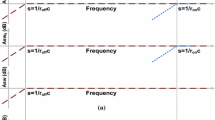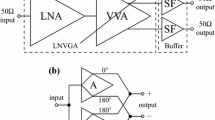Abstract
A novel single-stage variable-gain amplifier (VGA) based on transconductance \(g_{m}\)-ratio amplifier is analyzed and designed with wider linear-in-dB gain range and improved linearity. The variable-gain amplifier proposed here consists of an exponential control block, a current squarer and an amplifier block with both input and load degeneration. With the help of current squarer which gets square function of the output current from exponential control block, the VGA achieves the maximum linear gain range in single stage. Current squarer is proposed, which is designed with compensation technique to minimize the second-order effect caused by carrier mobility reduction in short channel MOSFET. To avoid the poor linearity performance of the \(g_{{m}}\)-ratio amplifiers, the distortion is analyzed and the linearity is improved by applying input and load degenerating technique. At the same power consumption, the input 1 dB compression point can be improved by nearly 8.78 dB. Simulation results show that the VGA can provide a gain variation range of 64.09 dB (from \(-35.59\) to 28.5 dB) with a 3-dB bandwidth from 47 to 640 MHz. The circuit consumes the maximum power 3.5 mW from a 1.8-V supply.









Similar content being viewed by others
References
H.F. Baghtash, A. Ayatollahi, A. Zero-Pole, Reposition based, 0.95-mW, 68-dB, linear-in-dB, constant-bandwidth variable gain amplifier. Circuits Syst. Signal Process. 33(5), 1353–1368 (2014)
I. Choi, H. Seo, B. Kim, Accurate dB-linear variable gain amplifier with gain error compensation. IEEE J. Solid-State Circuits 48(2), 456–464 (2013)
Z. Chen, Y. Zheng, C. Choong, M. Je, A low-power variable-gain amplifier with improved linearity: analysis and design. IEEE Trans. Circuits Syst. I Regul. Pap. 59(10), 2176–2185 (2012)
Q.-H. Duong, Q. Le, C.-W. Kim, S.-G. Lee, A 95-dB linear low-power variable gain amplifier. IEEE Trans. Circuits Syst. I Regul. Pap. 53(8), 1648–1657 (2006)
Q.-H. Duong, 86 dB 1.4 mW 1.8 V 0.07 mm\(^2\) single-stage variable gain amplifier in 0.18 \(\upmu \)m CMOS. Electron. Lett. 43(1), 19–20 (2007)
Y.-Y. Huang, W. Woo, H. Jeon, C.-H. Lee, J.S. Kenney, Compact wideband linear CMOS variable gain amplifier for analog-predistortion power amplifiers. IEEE Trans. Microw. Theory Tech. 60(1), 68–76 (2012)
D. Im, H.-T. Kim, K. Lee, A CMOS resistive feedback differential low-noise amplifier with enhanced loop gain for digital TV tuner applications. IEEE Trans. Microw. Theory Tech. 57(11), 2633–2642 (2009)
T.B. Kumar, K. Ma, K.S. Yeo, Temperature-compensated dB-linear digitally controlled variable gain amplifier with DC offset cancellation. IEEE Trans. Microw. Theory Tech. 61(7), 2648–2661 (2013)
H. Liu, X. Zhu, C.C. Boon, X.F. He, Cell-based variable gain amplifiers with accurate dB-linear characteristic in 0.18 CMOS technology. IEEE J. Solid-State Circuits 50(2), 586–596 (2015)
H.-H. Nguyen, H.-N. Nguyen, J.-S. Lee, S.-G. Lee, A binary weighted switching and reconfiguration-based programmable gain amplifier. IEEE Trans. Circuits Syst. II Express Briefs 56(9), 699–703 (2009)
R. Onet et al., Compact variable gain amplifier for a multistandard WLAN/WiMAX/LTE receiver. IEEE Trans. Circuits Syst. I Regul. Pap. 61(1), 247–257 (2014)
M. Parlak, M. Matsuo, J. Buckwalter, in A 6-bit wideband variable gain amplifier with low group delay variation in 90 nm CMOS, IEEE Silicon Monolithic Integrated Circuits RF Systematic Topical Meeting, Santa Clara, CA, USA, Jan 2012, pp. 147–150
S. Purighalla, B. Maundy, 4-Bit parallel-input exponential digital-to-analog converter in CMOS 0.18 \(\upmu \)m technology. Circuits Syst. Signal Process. 31(2), 413–433 (2012)
B. Rahmatian, S. Mirabbasi, A low-power 75dB digitally programmable variable-gain amplifier in 0.18\(\upmu \)m CMOS. Can. J. Elect Comput. Eng. 32(4), 181–186 (2007)
C.-C. Wang, C.-C. Huang, C.-L. Lee, 70 dB dynamic range CMOS wideband digital variable gain amplifier for AGC in DVB-T/H receivers. Circuits Syst. Signal Process. 27(3), 367–379 (2008)
Y. Wang, B. Afshar, Y. Lu, V.C. Gaudet, A.M. Niknejad, Design of a low power, inductorless wideband variable-gain amplifier for high speed receiver systems. IEEE Trans. Circuits Syst. I Regul. Pap. 59(4), 696–707 (2012)
Author information
Authors and Affiliations
Corresponding author
Additional information
This work was supported by National Natural Science Foundation of China (61234002, 61322405, 61306044, and 61376033), National High-tech Program of China (2013AA014103).
Rights and permissions
About this article
Cite this article
Wang, J., Zhu, Z. An Improved-Linearity, Single-Stage Variable-Gain Amplifier Using Current Squarer for Wider Gain Range. Circuits Syst Signal Process 35, 4550–4566 (2016). https://doi.org/10.1007/s00034-016-0273-z
Received:
Revised:
Accepted:
Published:
Issue Date:
DOI: https://doi.org/10.1007/s00034-016-0273-z




